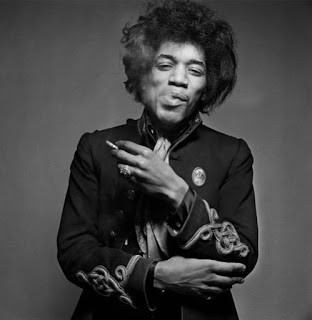 |
| The original portrait by Mankowitz |
Readers will remember that a couple of
years ago this blog wrote that the Paris Tribunal de Grand Instance (TGI) had
excluded that the well-known portrait of Jimi Hendrix realised by Gered Mankowitz would
be eligible for copyright protection.
1709
Blog friend and University of East Anglia academic Sabine Jacques has an update to report, this being
the rather different outcome of the appeal decision in this case earlier this
week.
Here's
what Sabine writes:
“After the surprising judgment of the TGI
Paris, the Paris Court of Appeal reversed the first instance decision with a ruling
delivered earlier this week.
In this case, an electronic cigarettes and
accessories sales company had reproduced and altered the famous portrait of
music legend Jimi Hendrix taken by Gered
Mankowitz for commercial advertising purposes. The defendant depicted Jimi
Hendrix smoking an electronic cigarette
instead of a real cigarette to
promote its products. Having been made aware of this unauthorised use, Gered
Mankowitz and his assignees decided to sue the electronic cigarettes sales
company for copyright infringement.
Let’s rewind
back to May 2015…
The decision of the TGI created somewhat a
seismic shock amongst practitioners and photographers as without expressly
acknowledging it, the High Court seemed to have interpreted the originality
criterion as being based upon artistic merits, thus going against Recital
16 Directive 2006/116/EC on the term of protection of copyright. Indeed, as
the black & white portrait featured the artist front-facing, with his waist
forward, exhaling smoke while bearing a half-smile and having his eyes half-closed,
the TGI was not convinced that the resulting work stemmed from the choices made
by the photographer instead of reflecting the artist’s own personality.
The TGI relied on both the Infopaq (Case
C-5/08) and Painer (Case
C-145/10) decisions. As a reminder, a work will be deemed original if it
represents the author’s own intellectual creation (Infopaq at [35]; Painer
at [88]). In relation to photographs, originality can be derived from the
numerous choices made by the author such as the subject, subject’s posture,
background, framing, lighting, time of the shooting, camera settings,
development techniques, device used, editing techniques, etc which can all reveal
the author’s own personality (Painer
at [91]). Here, the TGI held that the description of the author’s contribution
provided by the photographer was commonplace and could not be attributed to the
photographer without doubt. Therefore, based on the evidence submitted, the TGI
held that it could not appreciate originality, nor did it provide the
opportunity for the defendant to dispute this point.
Fast forward to June 2017…
Reversing the TGI decision, the Paris Court
of Appeal decided that the photograph was original and that, by using the
altered copyright-protected work to commercially promote their products online
and in two brick-and-mortar shops, the electronic cigarettes sales company had infringed
copyright.
The Court of Appeal confirmed that the
person claiming to have been copyright protection bears the burden of
proof. In other words, the photographer would
need to demonstrate where the originality lies in the portrait. Mr Mankowitz
therefore explained that he had organised the shooting in 1967 and directed the
rock star in terms of position and angle. The use of a specific camera and lens
was deliberate to create a wide-angle effect without distortion. Moreover, the
lightning, background, framing and angle of capture all resulted from
deliberate choices made by the photographer, embodying the expression of his
own personality.
Additionally (and perhaps surprising for
readers outside France), the Court of Appeal paid attention to the fact that
the photographer was internationally famous. As Mankowitz’s photographs are
equally well known, Jimi Hendrix’s portrait was deemed original.
Finally, in relation to the infringing acts,
the Court of Appeal held that the unauthorised reproduction and alteration of
the protected work for promotion purposes fell within the exclusive rights of
the author (L. 122-4 French Intellectual Property Code).
Remarks
While the outcome reached by the Court of
Appeal was expected, the litigation demonstrates that the originality criterion
is still developing in copyright legislation. By requiring, the right kind of evidence to be submitted,
French courts seem to demand that photographers deconstruct an image in a way
which can be at odds with creative processes. However, the take home message
for practitioners is perhaps to rely only on the deliberate choices made by a
photographer for the purposes of satisfying the originality requirement in
front of courts.
Besides, this case is interesting insofar as the Court of Appeal took into consideration the reputation of the photographer to determine originality. It is not the first time that French courts consider the reputation of the original author relevant for the application of copyright law. While it is undeniable that the portrait of Jimi Hendrix is original, one might wonder whether French courts believe that well-known works are more deserving of copyright protection than others. As this blogger is currently turning her thesis on the parody exception into a monograph, some French decisions directly come into mind. For example, in Société Moulinsart, Mm Fanny R. c/ Eric J. (decision in French here), the TGI Paris refused the application of the parody exception where the defendant depicted the famous comic character Tintin in scenarios being the antithesis of the world created by its author, Hergé. Although attempting to refrain from assessing the work’s artistic merits, French courts seem less lenient where a parody comments a work considered to be part of the cultural heritage, even if the rules of the genre appeared to be respected.
Finally, the use of the Jimi Hendrix’s portrait was for commercial advertising purposes. Given the context and the captions joint to the reproduction of the work, consumers could have been led to believe that the use had been authorised or the products endorsed by the right-holders. Therefore, the Court of Appeal was correct in deciding that the use of works for commercial advertising purposes, even if these are altered, should require permission. And this, even if the use had been for a parodic purpose…”






